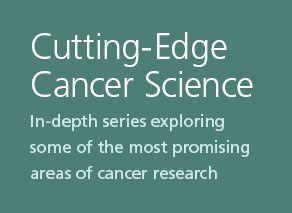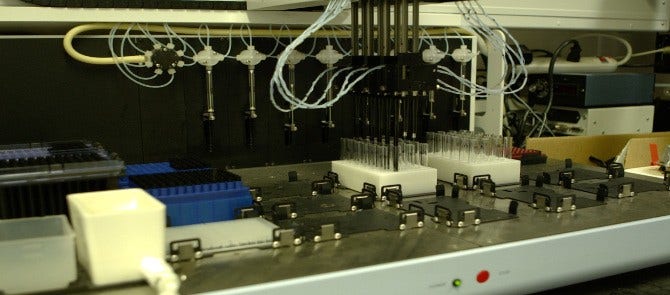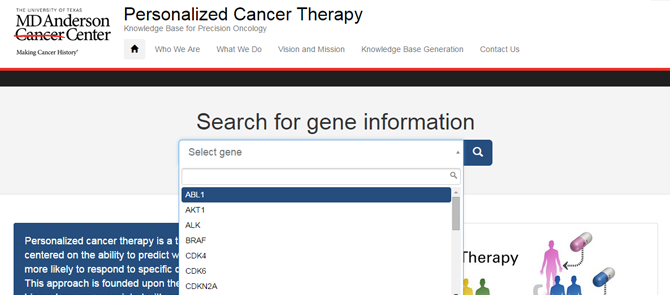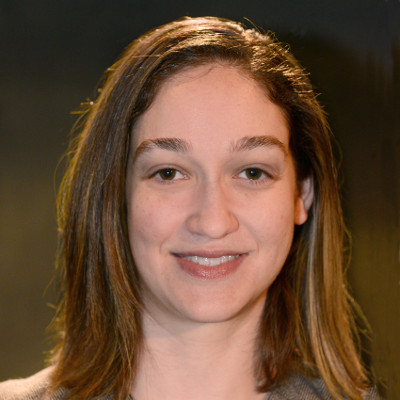Personalized Cancer Care: Where it Stands Today
This story is part of the American Cancer Society’s Cutting-Edge Cancer Science series, which is exploring some of the most promising areas of cancer research in depth.

This is part 2 of a 3-part feature exploring what personalized medicine means for cancer patients. Part 1 covers the basics of personalized cancer care and part 3 reviews personalized medicine for cancer prevention.

Researchers are working on a wide variety of tactics to achieve personalized cancer care. These include identifying as many genetic mutations as possible in different cancers, faster and more effective techniques for sequencing tumors, and new methods for more accurately matching treatments to patients and developing more targeted therapies.
Using Out-of-the-Box Techniques to Find the Right Treatments
Ross Cagan, Ph.D., a researcher at Mount Sinai Hospital in New York and a leader in the field of personalized cancer treatment is taking one of the more creative approaches to personalized cancer treatment – he is using fruit flies, bred to mimic the genetic mutations in cancer patients.
To do this, Cagan, who receives funding from the American Cancer Society, is drawing on many of the scientific and technological advances of recent years – from more powerful sequencing technology to the greater number of targeted drugs.
Cagan sequences DNA from a patient’s tumor to look for errors. He then replicates those errors in fruit flies to create what he calls fly avatars. “We change the fly DNA to match the patient's,” says Cagan. The flies eventually develop tumors and that’s when the drug testing part comes in. Cagan has a library of about 1,200 FDA-approved drugs. Some are cancer drugs, but most are not. He tests all of them against the tumors in the fruit flies.

(Photo: A liquid handler is used to move food and drugs into tubes. Fly embryos are then added as the next step in screening personalized avatars for drug cocktails that suppress effects of engineered tumors.)
Cagan breeds thousands of fly avatars for one patient so that he can test all of the drugs in his library multiple times. By doing this, he is able to come up with a cocktail of two to three drugs that work together against the tumor. Cagan passes on his findings to the patient and his or her oncologist.
After working for years to refine his fly avatar model, Cagan is now able to use the technique to help real patients through the Center for Personalized Cancer Therapeutics (CPCT) at Mount Sinai. (Learn more about Dr. Cagan's research by playing the video below.)
Developing Deep Databases of Genetic Information
Several centers focused on personalized cancer care have emerged in the past 5 to 10 years. Most of them are housed in major cancer centers. One that has been around for some time is MD Anderson Cancer Center’s Institute for Personalized Cancer Therapy. Instead of fruit flies, it relies on what its director, Gordon Mills, M.D., Ph.D., calls an “ultra-deep research platform.” Named T-200 because it is able to analyze a patient’s tumor against 200 different genetic aberrations, the platform provides Mills and his team with information about the specific genetic issues in the patient’s tumor.
Mills and his team at MD Anderson have also now developed a website for doctors and patients – the site is also open to the public – that allows the treating physician to look up a number of different genetic mutations and see if there is an approved drug or a clinical trial available to target the specific patient’s mutations. Mills said MD Anderson developed the website because “one of the challenges [with tumor profiling] is giving data back to the clinician in a manner in which it is useful.”

(Photo: The MD Anderson Institute for Personalized Cancer Therapy developed a website that helps physicians and patients assess potential therapy options based on specific tumor biomarkers.)
Identifying More Targets Will Mean More People Can Benefit from Personalized Medicine
Another important issue is that there are not yet enough targeted drugs to fit all the “actionable events” found in patient tumors, says Mills. “Currently only about 10% of [our] patients who undergo molecular testing go on to clinical trials specifically related to the genomic aberrations in their tumors.” One major reason for this is that “only half of them have an actionable event – a genomic event where a patient’s sequence change suggests a drug we should use,” says Mills.
Finding more targets for drugs – and developing the drugs themselves – is another massive area of research that scientists hope will lead to the expansion of personalized cancer care. One such scientist is Matthew Meyerson, M.D., Ph.D., of the Dana-Farber Cancer Institute. With the help of an American Cancer Society Research Professor grant, Meyerson is working “to identify all the cancer-causing mutations in lung cancer, and determine their impact on cancer risk, prognosis and treatment.”
“We know a lot of the mutated genes in lung cancer, but for most we don’t yet have any drugs to target them,” says Meyerson. Part of the challenge of drug development is trying to determine which mutations really matter. “This is an important question because cancers are filled with mutations, but most are passengers, meaning as far as our current knowledge tells us they have no role in causing cancer, and a fraction of those mutations are what we call drivers, meaning as far as we know currently they do promote cancer.”
To find more actionable mutations – or drivers – Meyerson and his team study lung cancer patients’ DNA. They compare the DNA sequence of a patient’s cancer with the sequence of normal DNA from the same patient to figure out the characteristics that are unique to the cancer. Then, to determine which mutations are the most important ones they use statistical analysis to answer the question: “Which of these [mutations] is most likely to be unique and recurrent in the cancers and to occur more often than you would expect by chance?”
Meyerson has been studying lung cancer genomics for about 17 years. He says “lung cancer is one of the forms of cancer that has benefited the most from the development of new personalized treatments.” Still, there is a lot left to learn he says. For example, Meyerson says it is important to think about the many patients who get lung cancer, but who have never smoked. “We don’t yet know what all the risks are that cause lung cancer in people who have never smoked.”
To figure out the answer, Meyerson says “we simply need to sequence a lot more cases of cancer.” “When you have cancer, and you have mutations, one of the challenges is to figure out which ones are important and which ones aren’t, and one of the big ways we can figure out which ones are important is to determine the sequences of a very large number of cancers.”
Challenges to Personalized Cancer Care
Myerson’s desire to sequence more cancers highlights a key barrier to implementing personalized cancer care on a large scale.
“The single most challenging problem with all of personalized medicine is how we are going to cover the cost of evaluating patient tumors,” says Mills. He’s not just referring to the cost of sequencing tumors, but also to “all the processes around it, such as building the DNA libraries and managing the data.”
Such systems will be necessary to help providers make use of the ballooning amounts of data available for each patient. “The next step is we need to get that information quickly and accurately to the treating physician in a manner that she or he can understand relatively easily,” Leonard Lichtenfeld, M.D., deputy chief medical officer for the American Cancer Society, wrote in a recent blog.
This is an area where the president’s Precision Medicine Initiative is putting a lot of focus.
As part of the proposed initiative, the National Cancer Institute will “build information platforms to support the integration of genetic information about tumors with data on how the tumors respond to therapy,” the outgoing NCI director wrote recently. “This component of the Precision Medicine Initiative is based on the expectation that the “big data” that emerges from precision medicine trials can be used to construct models that predict, with increasing accuracy, response to treatment.”
Developing and Testing Drugs to Fit Just One Person
Even if these large-scale databases of patient information get built, and doctors can easily identify all the mutations in a patient’s tumor, they still need to have a drug to treat what they find. But when it comes to making cancer care truly personal, drug development and testing are tricky.
“We are already in a situation where we know that the large majority of targets don't have a currently available drug,” says Lichtenfeld.
Mills says the challenge is proving that therapies crafted for an individual’s benefit are also going to be helpful for other patients. Essentially, in most cases, insurance companies will not cover certain treatments unless there have been clinical trials done that demonstrate increased survival relative to the current standard of care. Clinical trials involve the need to study many patients and can take long periods of time. “A single person trial is not something we know how to deal with in terms of statistical analysis,” says Mills.
This means that different, non-traditional types of clinical trials are needed to be able to more quickly bring new drugs to patients. Lichtenfeld says that the clinical trials system needs to be more efficient from a time and financial standpoint and in terms of being able to find the patients where they are. “We have to move to a point where, if I live in a small town somewhere, and if I have say colon cancer, that I can get my cancer tissue analyzed easily where I live and that data can be put into a databank and in the event a drug trial becomes available that databank can be searched and I can be put on trial.”
“Industry experts have shared with me that we will not make progress if we don’t get this type of infrastructure in place and implemented across the country,” says Lichtenfeld.
Taking Risks
Beyond changing the way clinical trials work, coming up with new creative approaches, such as Cagan’s fruit flies, may be a way to move personalized medicine forward. Cagan says he came up with the fruit fly model, in part, by taking a risk, which he says would not have been possible without the support he got from the American Cancer Society. “What we do doesn’t easily fit into any existing funding bin; there isn’t really a grant at the National Institutes of Health that funds building a fly avatar drug screening project,” Cagan says.
Cagan is hopeful, though, that the president’s initiative is going to help change this. “The president focusing on precision medicine or personalized medicine can only help NIH take more risks to fund personalized medicine.”
Bottom Line
“We need to emphasize to patients and to the public and funders and regulatory agencies that these are just very early days,” says Mills about personalized medicine. “We have to demonstrate that personalized cancer therapy, as a generalized approach, benefits patients and at same time results in cost containment.”
“We are going into an era of highly predictive medicine that is going to be very personalized – when that will happen I don’t know. It may or may not happen in my lifetime, but certainly will happen in my grandchildren's lifetime,” says Lichtenfeld (his grandchildren are currently 5 months, 1 year, and 3 years old).
READ PART 3: Personalized Cancer Prevention
Fruit Fly Avatars Fight Cancer
- For researchers
American Cancer Society news stories are copyrighted material and are not intended to be used as press releases. For reprint requests, please see our Content Usage Policy.



